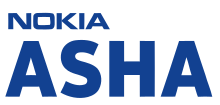Mobile VoIP or simply mVoIP is an extension of mobility to a voice over IP network. Two types of communication are generally supported: cordless telephones using DECT or PCS protocols for short range or campus communications where all base stations are linked into the same LAN, and wider area communications using 3G or 4G protocols.

The Nokia 6120 classic is a mid-range mobile phone from Nokia that was announced on 17 April 2007. It runs on Symbian v9.2 with a S60 3rd Edition FP1 user interface.
The Nokia 6000 series or Classic Business series is range of mobile phones marketed by Nokia. This family of phones is notable for their conservative, unisex designs, making them popular with business users.

Nokia 5300 XpressMusic is a slider mobile phone by Nokia, part of the XpressMusic range. It was introduced on 26 September 2006 and released at the end of that year. It runs on Nokia Series 40 3rd Edition FP2.
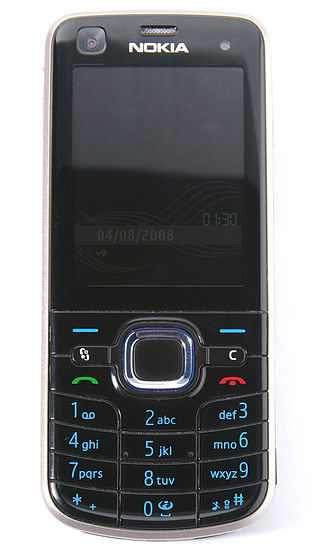
Nokia 6220 classic is a Symbian OS mobile phone announced by Nokia on 11 February 2008. It is notable for featuring a Xenon flash for its 5-megapixel camera, similar to Nokia N82 and often considered as a "budget" version of the N82. Despite its compact size, it offers features comparable to the Nseries lineup, though it lacks Wi-Fi and a 3.5 mm audio jack, probably to cut design and production costs.
The Nokia 3600 slide is a mobile phone by Nokia that was released in August 2008. The phone runs the Series 40 3rd Edition platform. This is classed as the 'low end version' of the Nokia 6600 slide, its major difference being the lack of 3G support.

The Nokia E63 is a mobile phone announced on 12 November 2008 and released later that year. It is based on Symbian's S60 software platform and is considered a budget business smartphone positioned below the Nokia E71, featuring a plastic body instead of metal. Many of the specifications are identical to the E71 except for the lack of GPS and infrared, a lesser RAM, lack of HSDPA and lower-resolution camera with a fixed-focus lens. The E63 does come with a flashlight function using the camera flash, which is not present in the E71. It also has a more standardized 3.5 mm audio jack whereas the E71 uses a 2.52 mm jack as used on older Nokia phones. The E63 retailed for about 199 euros before taxes. The device was succeeded by the Nokia E5, but remain in production until its discontinuation in late 2011 in favour of Nokia's Lumia lineup.

The Nokia E75 is a mobile phone from the Eseries range with a side sliding QWERTY keyboard and also front keypad.

The Nokia E52 and Nokia E55 are mobile phones from Nokia's business-oriented Eseries range. They run Symbian OS v9.3. The E55 was announced on 16 February 2009, whilst the E52 was announced later on 6 May 2009. They are both physically and functionally identical, except that the E55 has a 'half-QWERTY' keyboard, similar to the SureType keyboard on BlackBerry Pearl, whereas the E52 revision has a traditional T9 keypad.

The Nokia N900 is a smartphone made by Nokia. It supersedes the Nokia N810. Its default operating system, Maemo 5, is a Linux-based OS originally developed for the Nokia 770 Internet Tablet. It is the first Nokia device based upon the Texas Instruments OMAP3 microprocessor with the ARM Cortex-A8 core. Unlike the three Nokia Internet tablets preceding it, the Nokia N900 is the first Maemo device to include phone functionality.

The LG Versa (VX9600) is a mobile phone for use on the Verizon Wireless network. Like the LG Dare VX-9700, the Versa has a full touch screen and onscreen QWERTY keyboard. The Versa also accepts handwriting recognition or gesture control for entering phone numbers and typing. The phone includes a HTML mobile web web browser, a built-in MP3 music player, access to Verizon Wireless's VCAST multimedia services, and mobile e-mail services. The phone includes a 2.0-mp digital camera with zoom, autofocus, and flash. The phone also had a built-in camcorder. An expandable MicroSD card slot is included into the phone, though no MicroSD card is pre-installed into the device. The difference between the LG Dare and the Versa is that the Versa featured a unique, foldout QWERTY keyboard that was detachable. Originally included with the Versa, the QWERTY keyboard was no longer included and only available as an accessory at Verizon Wireless retail stores. The attachment also included send and end call keys so that the user could answer an incoming call even with the flip closed. The attachment also included an integrated LED display screen that displayed information such as the currently-playing music track, current time, current date, signal strength, type of CDMA signal that the phone was currently operating on, the network provider's name, and who is calling, should an incoming call come through when the case is attached and closed.

The Nokia X3 Touch and Type also known as Nokia X3-02 is a smartphone handset produced by Nokia. This is the first mobile handset released by Nokia that possesses a touchscreen in a "candybar" phone form factor. It is also the first touchscreen handset from Nokia that runs the Series 40 operating system. Previously released touchscreen devices from Nokia have either not had a physical keyboard, or they have had a slide-out, full-QWERTY keyboard. It was introduced on 13 August 2010 as one of the most advanced Series 40 devices in terms of features and specifications.
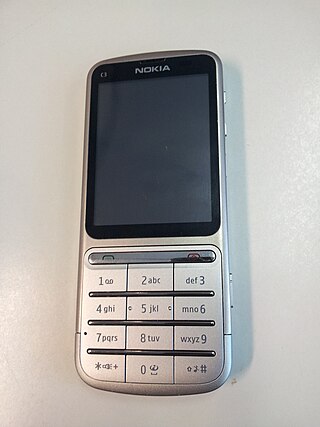
The Nokia C3 Touch and Type, also known as the C3-01, is a smartphone handset produced by Nokia. It is the second mobile handset released by Nokia that possesses a touchscreen in a "candy bar" phone form factor and runs the Series 40 operating system. The C3-01 was announced on September 15, 2010. It has a stainless steel body, a 2.4" display, a 5-megapixel camera with flash, Wi-Fi, and 3G.
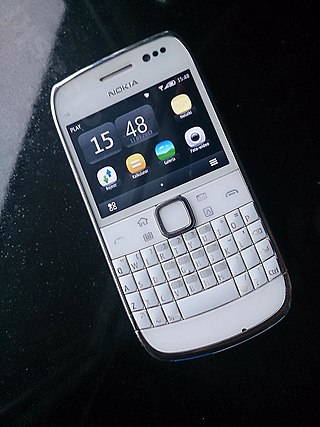
The Nokia E6-00 is a mobile phone running the Symbian^3 operating system. It supersedes the Nokia E72 as the new Symbian business mobility solution from Nokia following its announcement on 12 April 2011. It shipped with the new "Symbian Anna" version of Symbian^3, and originally retailed for 340 euros before taxes.

The Nokia N9 is a flagship smartphone developed by Nokia, running on the Linux-based MeeGo mobile operating system. Announced in June 2011 and released in September, it was the first and only device from Nokia with MeeGo, partly because of the company's partnership with Microsoft announced that year. It was initially released in three colors: black, cyan and magenta, before a white version was announced at Nokia World 2011.
Nokia's strategic nomenclature can be traced back in 2005 when the Nseries line was launched, offering devices with flagship specifications and premium hardware at various price points. These devices were considered the "bread and butter" of the company and were often positioned to showcase their latest technologies. Thanks to the newfound consumer and enterprise interest in smartphones at the time, the company introduced four additional collections to diversify their product portfolio and meet demands in most market segments. These new phone series were named Eseries, targeting small business and enterprise customers; Xseries, providing consumer-grade multimedia-focused devices; Cseries, which Nokia used to target both the low-end and mid-range market segments; and Tseries, for devices exclusive to the Chinese market.
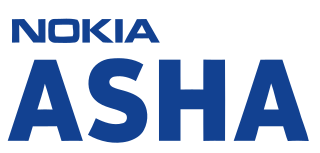
The Nokia Asha 303 is a QWERTY messenger smartphone powered by Nokia's Series 40 operating system. It was announced at Nokia World 2011 in London along with three others Asha phones - the Nokia Asha 200, 201 and 300. The 303 is considered to be the flagship of the Asha family. Its main features are the QWERTY keyboard and capacitive touchscreen, the pentaband 3G radio, SIP VoIP over 3G and Wi-Fi and the ability to play Angry Birds which were all never seen before on a Series 40 phone. Nokia Asha 303 is available in a number of languages depending on which territory it is marketed for. Models sold in South Asia support at least eight languages: English, Hindi, Gujarati, Marathi, Tamil, Kannada, Telugu and Malayalam.

The Nokia Asha 306 is a "Full Touch" phone powered by Nokia's Series 40 operating system. It was announced at Bangkok by Nokia along with two others Asha Full Touch phones - the Nokia Asha 305 and 311. The 306 is considered to be the little brother of Asha 311 as it lacks 3G and capacitive touch screen. Its main features are the Full Touch resistive touchscreen and WLAN.

The Nokia Asha 305 is a "Full Touch" phone powered by Nokia's Series 40 operating system. It was announced at Bangkok by Nokia along with two other Asha Full Touch phones - the Nokia Asha 306 and 311. Its main features are the Full Touch resistive touchscreen and dual SIM.

The Nokia Asha 310, also known as the Nokia Asha 3010 or the Nokia ASHA 310 RM-911, was released in March 2013. It is the first in the line of the Asha range of phones to have dual subscriber identity module (SIM) slots and Wi-Fi connectivity. It was a reinvention of the Asha range to remain competitive with new Android devices. It cost $102.00 at its launch date. It has a touchscreen, comes with either a 2 or 4 GB micro SD card, and has 64 MB of RAM, a 2 MP camera and a battery that can last up to 600 hours in standby mode. The phone can play music for up to 54 hours or video for up to 9.5 hours, and has a maximum of 17 hours talk time (2G).
